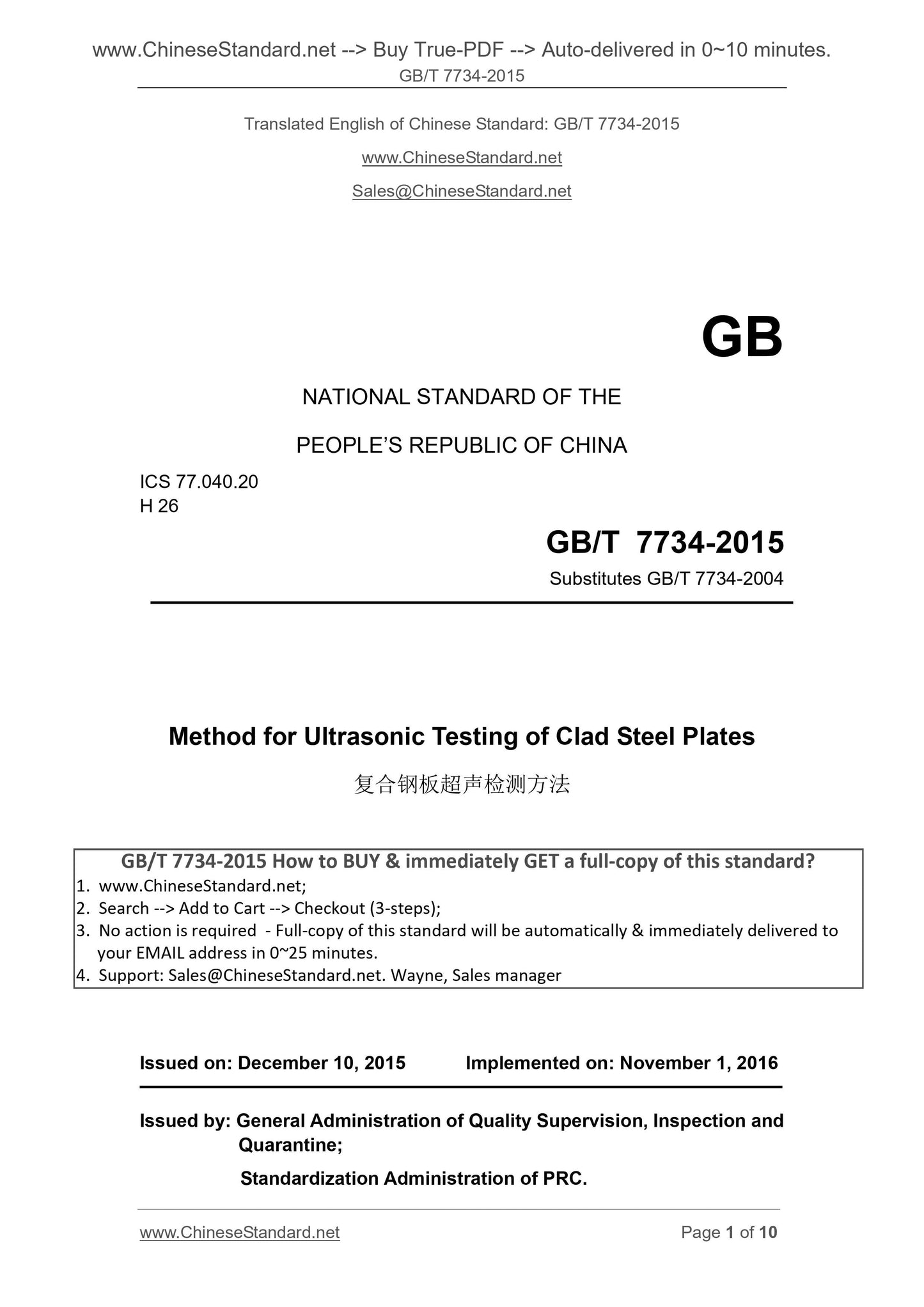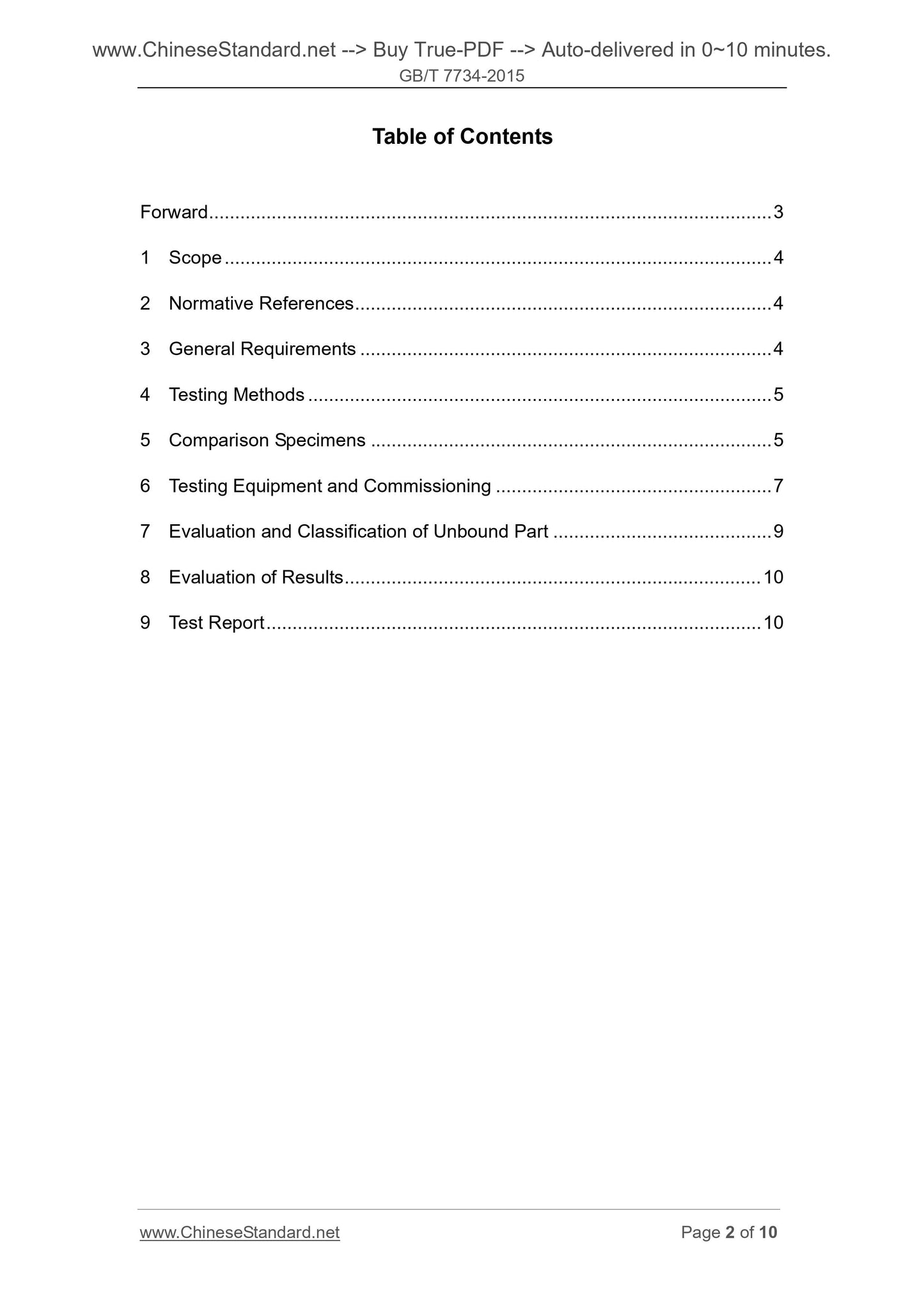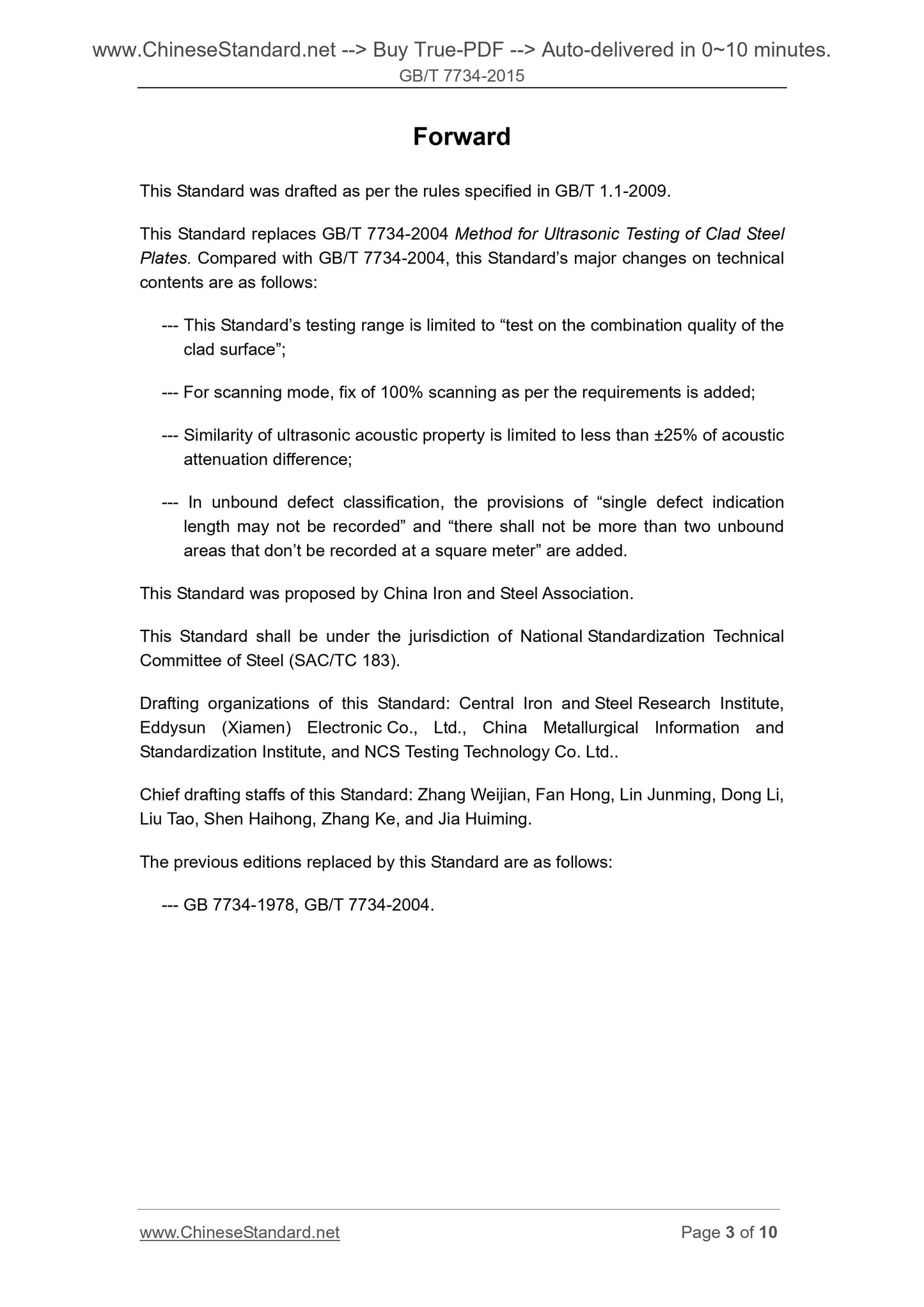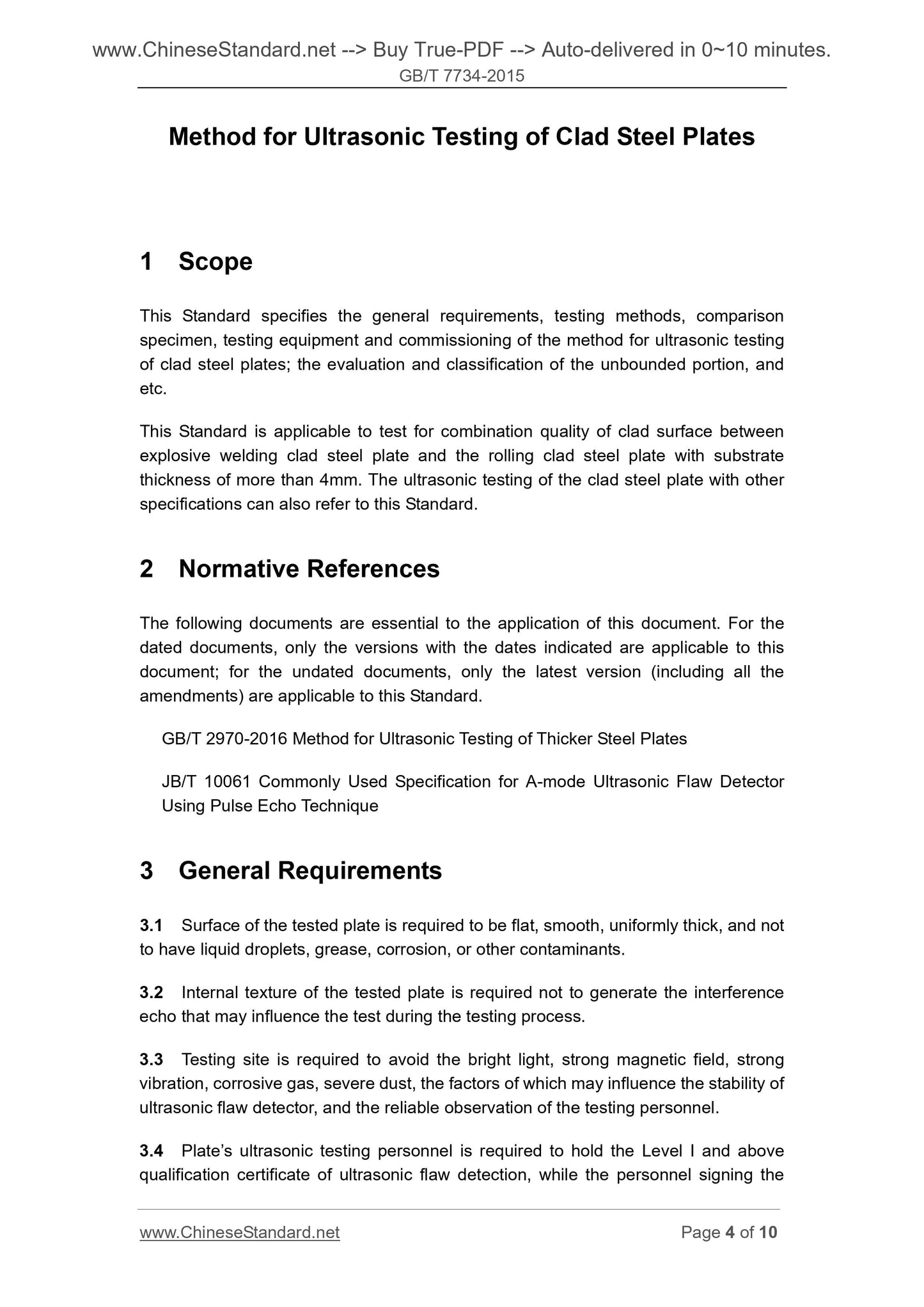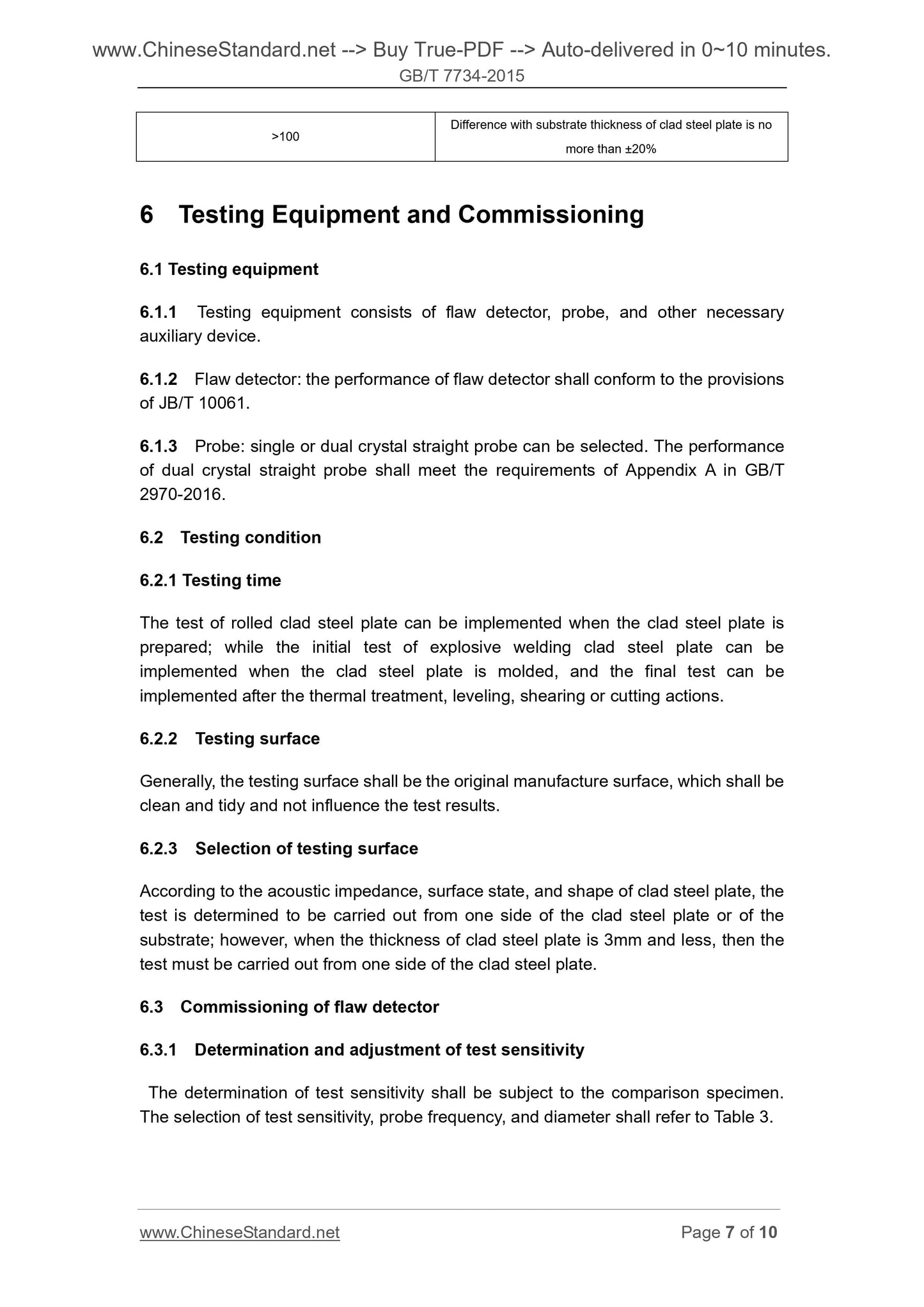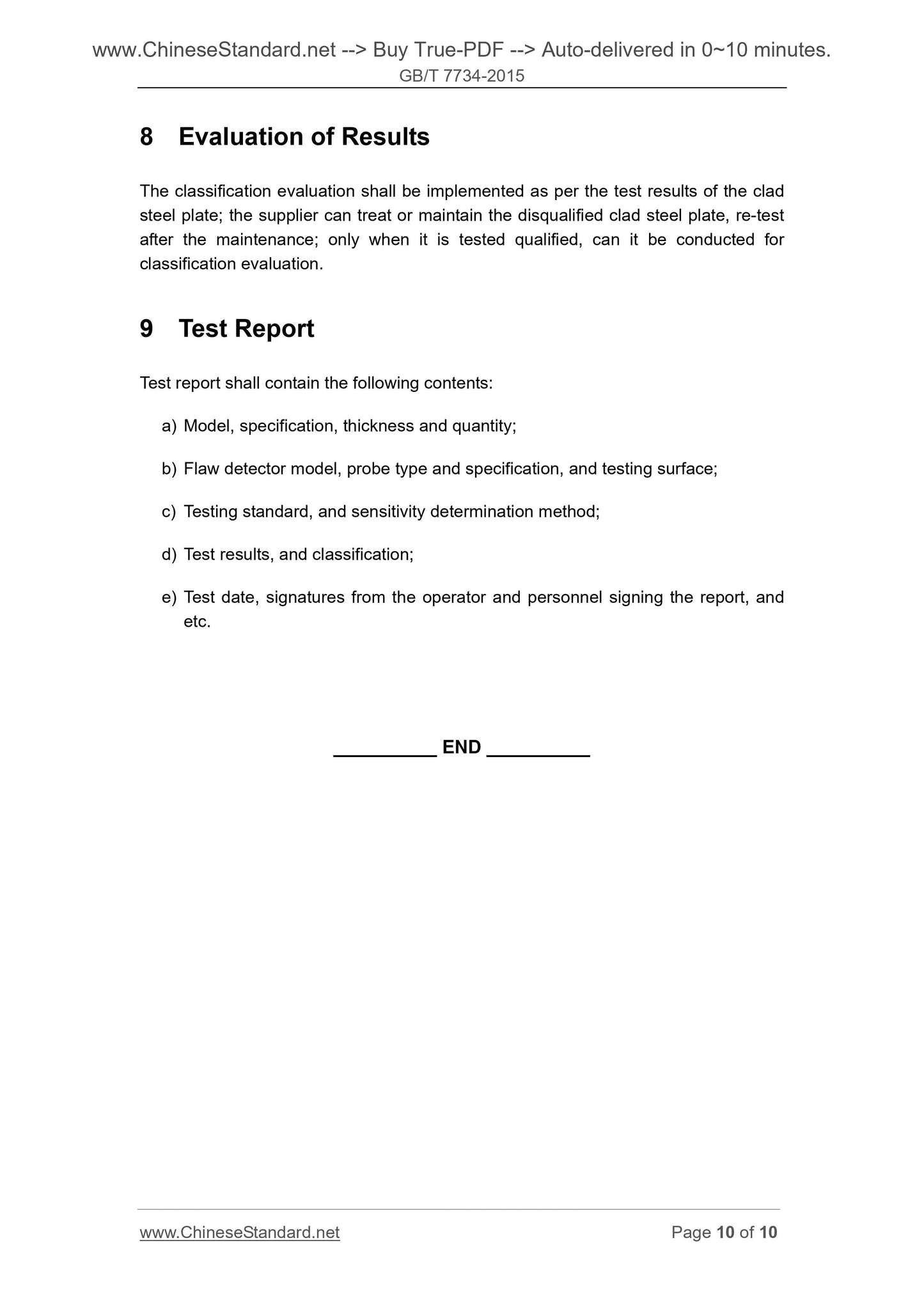1
/
of
6
www.ChineseStandard.us -- Field Test Asia Pte. Ltd.
GB/T 7734-2015 English PDF (GB/T7734-2015)
GB/T 7734-2015 English PDF (GB/T7734-2015)
Regular price
$85.00
Regular price
Sale price
$85.00
Unit price
/
per
Shipping calculated at checkout.
Couldn't load pickup availability
GB/T 7734-2015: Method for Ultrasonic Testing of Clad Steel Plates
Delivery: 9 seconds. Download (& Email) true-PDF + Invoice.
Get Quotation: Click GB/T 7734-2015 (Self-service in 1-minute)
Historical versions (Master-website): GB/T 7734-2015
Preview True-PDF (Reload/Scroll-down if blank)
GB/T 7734-2015
GB
NATIONAL STANDARD OF THE
PEOPLE’S REPUBLIC OF CHINA
ICS 77.040.20
H 26
Substitutes GB/T 7734-2004
Method for Ultrasonic Testing of Clad Steel Plates
ISSUED ON. DECEMBER 10, 2015
IMPLEMENTED ON. NOVEMBER 1, 2016
Issued by. General Administration of Quality Supervision, Inspection and
Quarantine;
Standardization Administration of PRC.
Table of Contents
Forward ... 3
1 Scope ... 4
2 Normative References ... 4
3 General Requirements ... 4
4 Testing Methods ... 5
5 Comparison Specimens ... 5
6 Testing Equipment and Commissioning ... 7
7 Evaluation and Classification of Unbound Part ... 9
8 Evaluation of Results ... 10
9 Test Report ... 10
Forward
This Standard was drafted as per the rules specified in GB/T 1.1-2009.
This Standard replaces GB/T 7734-2004 Method for Ultrasonic Testing of Clad Steel
Plates. Compared with GB/T 7734-2004, this Standard’s major changes on technical
contents are as follows.
--- This Standard’s testing range is limited to “test on the combination quality of the
clad surface”;
--- For scanning mode, fix of 100% scanning as per the requirements is added;
--- Similarity of ultrasonic acoustic property is limited to less than ±25% of acoustic
attenuation difference;
--- In unbound defect classification, the provisions of “single defect indication
length may not be recorded” and “there shall not be more than two unbound
areas that don’t be recorded at a square meter” are added.
This Standard was proposed by China Iron and Steel Association.
This Standard shall be under the jurisdiction of National Standardization Technical
Committee of Steel (SAC/TC 183).
Drafting organizations of this Standard. Central Iron and Steel Research Institute,
Eddysun (Xiamen) Electronic Co., Ltd., China Metallurgical Information and
Standardization Institute, and NCS Testing Technology Co. Ltd..
Chief drafting staffs of this Standard. Zhang Weijian, Fan Hong, Lin Junming, Dong Li,
Liu Tao, Shen Haihong, Zhang Ke, and Jia Huiming.
The previous editions replaced by this Standard are as follows.
--- GB 7734-1978, GB/T 7734-2004.
Method for Ultrasonic Testing of Clad Steel Plates
1 Scope
This Standard specifies the general requirements, testing methods, comparison
specimen, testing equipment and commissioning of the method for ultrasonic testing
of clad steel plates; the evaluation and classification of the unbounded portion, and
etc.
This Standard is applicable to test for combination quality of clad surface between
explosive welding clad steel plate and the rolling clad steel plate with substrate
thickness of more than 4mm. The ultrasonic testing of the clad steel plate with other
specifications can also refer to this Standard.
2 Normative References
The following documents are essential to the application of this document. For the
dated documents, only the versions with the dates indicated are applicable to this
document; for the undated documents, only the latest version (including all the
amendments) are applicable to this Standard.
GB/T 2970-2016 Method for Ultrasonic Testing of Thicker Steel Plates
JB/T 10061 Commonly Used Specification for A-mode Ultrasonic Flaw Detector
Using Pulse Echo Technique
3 General Requirements
3.1 Surface of the tested plate is required to be flat, smooth, uniformly thick, and not
to have liquid droplets, grease, corrosion, or other contaminants.
3.2 Internal texture of the tested plate is required not to generate the interference
echo that may influence the test during the testing process.
3.3 Testing site is required to avoid the bright light, strong magnetic field, strong
vibration, corrosive gas, severe dust, the factors of which may influence the stability of
ultrasonic flaw detector, and the reliable observation of the testing personnel.
3.4 Plate’s ultrasonic testing personnel is required to hold the Level I and above
qualification certificate of ultrasonic flaw detection, while the personnel signing the
>100 Difference with substrate thickness of clad steel plate is no more than ±20%
6 Testing Equipment and Commissioning
6.1 Testing equipment
6.1.1 Testing equipment consists of flaw detector, probe, and other necessary
auxiliary device.
6.1.2 Flaw detector. the performance of flaw detector shall conform to the provisions
of JB/T 10061.
6.1.3 Probe. single or dual crystal straight probe can be selected. The performance
of dual crystal straight probe shall meet the requirements of Appendix A in GB/T
2970-2016.
6.2 Testing condition
6.2.1 Testing time
The test of rolled clad steel plate can be implemented when the clad steel plate is
prepared; while the initial test of explosive welding clad steel plate can be
implemented when the clad steel plate is molded, and the final test can be
implemented after the thermal treatment, leveling, shearing or cutting actions.
6.2.2 Testing surface
Generally, the testing surface shall be the original manufacture surface, which shall be
clean and tidy and not influence the test results.
6.2.3 Selection of testing surface
According to the acoustic impedance, surface state, and shape of clad steel plate, the
test is determined to be carried out from one side of the clad steel plate or of the
substrate; however, when the thickness of clad steel plate is 3mm and less, then the
test must be carried out from one side of the clad steel plate.
6.3 Commissioning of flaw detector
6.3.1 Determination and adjustment of test sensitivity
The determination of test sensitivity shall be subject to the comparison specimen.
The selection of test sensitivity, probe frequency, and diameter shall refer to Table 3.
8 Evaluation of Results
The classification evaluation shall be implemented as per the test results of the clad
steel plate; the supplier can treat or maintain the disqualified clad steel plate, re-test
after the maintenance; only when it is tested qualified, can it be conducted for
classification evaluation.
9 Test Report
Test report shall contain the following contents.
a) Model, specification, thickness and quantity;
b) Flaw detector model, probe type and specification, and testing surface;
c) Testing standard, and sensitivity determination method;
d) Test results, and classification;
e) Test date, signatures from the operator and personnel signing the report, and
etc.
GB/T 7734-2015
GB
NATIONAL STANDARD OF THE
PEOPLE’S REPUBLIC OF CHINA
ICS 77.040.20
H 26
Substitutes GB/T 7734-2004
Method for Ultrasonic Testing of Clad Steel Plates
ISSUED ON. DECEMBER 10, 2015
IMPLEMENTED ON. NOVEMBER 1, 2016
Issued by. General Administration of Quality Supervision, Inspection and
Quarantine;
Standardization Administration of PRC.
Table of Contents
Forward ... 3
1 Scope ... 4
2 Normative References ... 4
3 General Requirements ... 4
4 Testing Methods ... 5
5 Comparison Specimens ... 5
6 Testing Equipment and Commissioning ... 7
7 Evaluation and Classification of Unbound Part ... 9
8 Evaluation of Results ... 10
9 Test Report ... 10
Forward
This Standard was drafted as per the rules specified in GB/T 1.1-2009.
This Standard replaces GB/T 7734-2004 Method for Ultrasonic Testing of Clad Steel
Plates. Compared with GB/T 7734-2004, this Standard’s major changes on technical
contents are as follows.
--- This Standard’s testing range is limited to “test on the combination quality of the
clad surface”;
--- For scanning mode, fix of 100% scanning as per the requirements is added;
--- Similarity of ultrasonic acoustic property is limited to less than ±25% of acoustic
attenuation difference;
--- In unbound defect classification, the provisions of “single defect indication
length may not be recorded” and “there shall not be more than two unbound
areas that don’t be recorded at a square meter” are added.
This Standard was proposed by China Iron and Steel Association.
This Standard shall be under the jurisdiction of National Standardization Technical
Committee of Steel (SAC/TC 183).
Drafting organizations of this Standard. Central Iron and Steel Research Institute,
Eddysun (Xiamen) Electronic Co., Ltd., China Metallurgical Information and
Standardization Institute, and NCS Testing Technology Co. Ltd..
Chief drafting staffs of this Standard. Zhang Weijian, Fan Hong, Lin Junming, Dong Li,
Liu Tao, Shen Haihong, Zhang Ke, and Jia Huiming.
The previous editions replaced by this Standard are as follows.
--- GB 7734-1978, GB/T 7734-2004.
Method for Ultrasonic Testing of Clad Steel Plates
1 Scope
This Standard specifies the general requirements, testing methods, comparison
specimen, testing equipment and commissioning of the method for ultrasonic testing
of clad steel plates; the evaluation and classification of the unbounded portion, and
etc.
This Standard is applicable to test for combination quality of clad surface between
explosive welding clad steel plate and the rolling clad steel plate with substrate
thickness of more than 4mm. The ultrasonic testing of the clad steel plate with other
specifications can also refer to this Standard.
2 Normative References
The following documents are essential to the application of this document. For the
dated documents, only the versions with the dates indicated are applicable to this
document; for the undated documents, only the latest version (including all the
amendments) are applicable to this Standard.
GB/T 2970-2016 Method for Ultrasonic Testing of Thicker Steel Plates
JB/T 10061 Commonly Used Specification for A-mode Ultrasonic Flaw Detector
Using Pulse Echo Technique
3 General Requirements
3.1 Surface of the tested plate is required to be flat, smooth, uniformly thick, and not
to have liquid droplets, grease, corrosion, or other contaminants.
3.2 Internal texture of the tested plate is required not to generate the interference
echo that may influence the test during the testing process.
3.3 Testing site is required to avoid the bright light, strong magnetic field, strong
vibration, corrosive gas, severe dust, the factors of which may influence the stability of
ultrasonic flaw detector, and the reliable observation of the testing personnel.
3.4 Plate’s ultrasonic testing personnel is required to hold the Level I and above
qualification certificate of ultrasonic flaw detection, while the personnel signing the
>100 Difference with substrate thickness of clad steel plate is no more than ±20%
6 Testing Equipment and Commissioning
6.1 Testing equipment
6.1.1 Testing equipment consists of flaw detector, probe, and other necessary
auxiliary device.
6.1.2 Flaw detector. the performance of flaw detector shall conform to the provisions
of JB/T 10061.
6.1.3 Probe. single or dual crystal straight probe can be selected. The performance
of dual crystal straight probe shall meet the requirements of Appendix A in GB/T
2970-2016.
6.2 Testing condition
6.2.1 Testing time
The test of rolled clad steel plate can be implemented when the clad steel plate is
prepared; while the initial test of explosive welding clad steel plate can be
implemented when the clad steel plate is molded, and the final test can be
implemented after the thermal treatment, leveling, shearing or cutting actions.
6.2.2 Testing surface
Generally, the testing surface shall be the original manufacture surface, which shall be
clean and tidy and not influence the test results.
6.2.3 Selection of testing surface
According to the acoustic impedance, surface state, and shape of clad steel plate, the
test is determined to be carried out from one side of the clad steel plate or of the
substrate; however, when the thickness of clad steel plate is 3mm and less, then the
test must be carried out from one side of the clad steel plate.
6.3 Commissioning of flaw detector
6.3.1 Determination and adjustment of test sensitivity
The determination of test sensitivity shall be subject to the comparison specimen.
The selection of test sensitivity, probe frequency, and diameter shall refer to Table 3.
8 Evaluation of Results
The classification evaluation shall be implemented as per the test results of the clad
steel plate; the supplier can treat or maintain the disqualified clad steel plate, re-test
after the maintenance; only when it is tested qualified, can it be conducted for
classification evaluation.
9 Test Report
Test report shall contain the following contents.
a) Model, specification, thickness and quantity;
b) Flaw detector model, probe type and specification, and testing surface;
c) Testing standard, and sensitivity determination method;
d) Test results, and classification;
e) Test date, signatures from the operator and personnel signing the report, and
etc.
Delivery: 9 seconds. Download (& Email) true-PDF + Invoice.
Get Quotation: Click GB/T 7734-2015 (Self-service in 1-minute)
Historical versions (Master-website): GB/T 7734-2015
Preview True-PDF (Reload/Scroll-down if blank)
GB/T 7734-2015
GB
NATIONAL STANDARD OF THE
PEOPLE’S REPUBLIC OF CHINA
ICS 77.040.20
H 26
Substitutes GB/T 7734-2004
Method for Ultrasonic Testing of Clad Steel Plates
ISSUED ON. DECEMBER 10, 2015
IMPLEMENTED ON. NOVEMBER 1, 2016
Issued by. General Administration of Quality Supervision, Inspection and
Quarantine;
Standardization Administration of PRC.
Table of Contents
Forward ... 3
1 Scope ... 4
2 Normative References ... 4
3 General Requirements ... 4
4 Testing Methods ... 5
5 Comparison Specimens ... 5
6 Testing Equipment and Commissioning ... 7
7 Evaluation and Classification of Unbound Part ... 9
8 Evaluation of Results ... 10
9 Test Report ... 10
Forward
This Standard was drafted as per the rules specified in GB/T 1.1-2009.
This Standard replaces GB/T 7734-2004 Method for Ultrasonic Testing of Clad Steel
Plates. Compared with GB/T 7734-2004, this Standard’s major changes on technical
contents are as follows.
--- This Standard’s testing range is limited to “test on the combination quality of the
clad surface”;
--- For scanning mode, fix of 100% scanning as per the requirements is added;
--- Similarity of ultrasonic acoustic property is limited to less than ±25% of acoustic
attenuation difference;
--- In unbound defect classification, the provisions of “single defect indication
length may not be recorded” and “there shall not be more than two unbound
areas that don’t be recorded at a square meter” are added.
This Standard was proposed by China Iron and Steel Association.
This Standard shall be under the jurisdiction of National Standardization Technical
Committee of Steel (SAC/TC 183).
Drafting organizations of this Standard. Central Iron and Steel Research Institute,
Eddysun (Xiamen) Electronic Co., Ltd., China Metallurgical Information and
Standardization Institute, and NCS Testing Technology Co. Ltd..
Chief drafting staffs of this Standard. Zhang Weijian, Fan Hong, Lin Junming, Dong Li,
Liu Tao, Shen Haihong, Zhang Ke, and Jia Huiming.
The previous editions replaced by this Standard are as follows.
--- GB 7734-1978, GB/T 7734-2004.
Method for Ultrasonic Testing of Clad Steel Plates
1 Scope
This Standard specifies the general requirements, testing methods, comparison
specimen, testing equipment and commissioning of the method for ultrasonic testing
of clad steel plates; the evaluation and classification of the unbounded portion, and
etc.
This Standard is applicable to test for combination quality of clad surface between
explosive welding clad steel plate and the rolling clad steel plate with substrate
thickness of more than 4mm. The ultrasonic testing of the clad steel plate with other
specifications can also refer to this Standard.
2 Normative References
The following documents are essential to the application of this document. For the
dated documents, only the versions with the dates indicated are applicable to this
document; for the undated documents, only the latest version (including all the
amendments) are applicable to this Standard.
GB/T 2970-2016 Method for Ultrasonic Testing of Thicker Steel Plates
JB/T 10061 Commonly Used Specification for A-mode Ultrasonic Flaw Detector
Using Pulse Echo Technique
3 General Requirements
3.1 Surface of the tested plate is required to be flat, smooth, uniformly thick, and not
to have liquid droplets, grease, corrosion, or other contaminants.
3.2 Internal texture of the tested plate is required not to generate the interference
echo that may influence the test during the testing process.
3.3 Testing site is required to avoid the bright light, strong magnetic field, strong
vibration, corrosive gas, severe dust, the factors of which may influence the stability of
ultrasonic flaw detector, and the reliable observation of the testing personnel.
3.4 Plate’s ultrasonic testing personnel is required to hold the Level I and above
qualification certificate of ultrasonic flaw detection, while the personnel signing the
>100 Difference with substrate thickness of clad steel plate is no more than ±20%
6 Testing Equipment and Commissioning
6.1 Testing equipment
6.1.1 Testing equipment consists of flaw detector, probe, and other necessary
auxiliary device.
6.1.2 Flaw detector. the performance of flaw detector shall conform to the provisions
of JB/T 10061.
6.1.3 Probe. single or dual crystal straight probe can be selected. The performance
of dual crystal straight probe shall meet the requirements of Appendix A in GB/T
2970-2016.
6.2 Testing condition
6.2.1 Testing time
The test of rolled clad steel plate can be implemented when the clad steel plate is
prepared; while the initial test of explosive welding clad steel plate can be
implemented when the clad steel plate is molded, and the final test can be
implemented after the thermal treatment, leveling, shearing or cutting actions.
6.2.2 Testing surface
Generally, the testing surface shall be the original manufacture surface, which shall be
clean and tidy and not influence the test results.
6.2.3 Selection of testing surface
According to the acoustic impedance, surface state, and shape of clad steel plate, the
test is determined to be carried out from one side of the clad steel plate or of the
substrate; however, when the thickness of clad steel plate is 3mm and less, then the
test must be carried out from one side of the clad steel plate.
6.3 Commissioning of flaw detector
6.3.1 Determination and adjustment of test sensitivity
The determination of test sensitivity shall be subject to the comparison specimen.
The selection of test sensitivity, probe frequency, and diameter shall refer to Table 3.
8 Evaluation of Results
The classification evaluation shall be implemented as per the test results of the clad
steel plate; the supplier can treat or maintain the disqualified clad steel plate, re-test
after the maintenance; only when it is tested qualified, can it be conducted for
classification evaluation.
9 Test Report
Test report shall contain the following contents.
a) Model, specification, thickness and quantity;
b) Flaw detector model, probe type and specification, and testing surface;
c) Testing standard, and sensitivity determination method;
d) Test results, and classification;
e) Test date, signatures from the operator and personnel signing the report, and
etc.
GB/T 7734-2015
GB
NATIONAL STANDARD OF THE
PEOPLE’S REPUBLIC OF CHINA
ICS 77.040.20
H 26
Substitutes GB/T 7734-2004
Method for Ultrasonic Testing of Clad Steel Plates
ISSUED ON. DECEMBER 10, 2015
IMPLEMENTED ON. NOVEMBER 1, 2016
Issued by. General Administration of Quality Supervision, Inspection and
Quarantine;
Standardization Administration of PRC.
Table of Contents
Forward ... 3
1 Scope ... 4
2 Normative References ... 4
3 General Requirements ... 4
4 Testing Methods ... 5
5 Comparison Specimens ... 5
6 Testing Equipment and Commissioning ... 7
7 Evaluation and Classification of Unbound Part ... 9
8 Evaluation of Results ... 10
9 Test Report ... 10
Forward
This Standard was drafted as per the rules specified in GB/T 1.1-2009.
This Standard replaces GB/T 7734-2004 Method for Ultrasonic Testing of Clad Steel
Plates. Compared with GB/T 7734-2004, this Standard’s major changes on technical
contents are as follows.
--- This Standard’s testing range is limited to “test on the combination quality of the
clad surface”;
--- For scanning mode, fix of 100% scanning as per the requirements is added;
--- Similarity of ultrasonic acoustic property is limited to less than ±25% of acoustic
attenuation difference;
--- In unbound defect classification, the provisions of “single defect indication
length may not be recorded” and “there shall not be more than two unbound
areas that don’t be recorded at a square meter” are added.
This Standard was proposed by China Iron and Steel Association.
This Standard shall be under the jurisdiction of National Standardization Technical
Committee of Steel (SAC/TC 183).
Drafting organizations of this Standard. Central Iron and Steel Research Institute,
Eddysun (Xiamen) Electronic Co., Ltd., China Metallurgical Information and
Standardization Institute, and NCS Testing Technology Co. Ltd..
Chief drafting staffs of this Standard. Zhang Weijian, Fan Hong, Lin Junming, Dong Li,
Liu Tao, Shen Haihong, Zhang Ke, and Jia Huiming.
The previous editions replaced by this Standard are as follows.
--- GB 7734-1978, GB/T 7734-2004.
Method for Ultrasonic Testing of Clad Steel Plates
1 Scope
This Standard specifies the general requirements, testing methods, comparison
specimen, testing equipment and commissioning of the method for ultrasonic testing
of clad steel plates; the evaluation and classification of the unbounded portion, and
etc.
This Standard is applicable to test for combination quality of clad surface between
explosive welding clad steel plate and the rolling clad steel plate with substrate
thickness of more than 4mm. The ultrasonic testing of the clad steel plate with other
specifications can also refer to this Standard.
2 Normative References
The following documents are essential to the application of this document. For the
dated documents, only the versions with the dates indicated are applicable to this
document; for the undated documents, only the latest version (including all the
amendments) are applicable to this Standard.
GB/T 2970-2016 Method for Ultrasonic Testing of Thicker Steel Plates
JB/T 10061 Commonly Used Specification for A-mode Ultrasonic Flaw Detector
Using Pulse Echo Technique
3 General Requirements
3.1 Surface of the tested plate is required to be flat, smooth, uniformly thick, and not
to have liquid droplets, grease, corrosion, or other contaminants.
3.2 Internal texture of the tested plate is required not to generate the interference
echo that may influence the test during the testing process.
3.3 Testing site is required to avoid the bright light, strong magnetic field, strong
vibration, corrosive gas, severe dust, the factors of which may influence the stability of
ultrasonic flaw detector, and the reliable observation of the testing personnel.
3.4 Plate’s ultrasonic testing personnel is required to hold the Level I and above
qualification certificate of ultrasonic flaw detection, while the personnel signing the
>100 Difference with substrate thickness of clad steel plate is no more than ±20%
6 Testing Equipment and Commissioning
6.1 Testing equipment
6.1.1 Testing equipment consists of flaw detector, probe, and other necessary
auxiliary device.
6.1.2 Flaw detector. the performance of flaw detector shall conform to the provisions
of JB/T 10061.
6.1.3 Probe. single or dual crystal straight probe can be selected. The performance
of dual crystal straight probe shall meet the requirements of Appendix A in GB/T
2970-2016.
6.2 Testing condition
6.2.1 Testing time
The test of rolled clad steel plate can be implemented when the clad steel plate is
prepared; while the initial test of explosive welding clad steel plate can be
implemented when the clad steel plate is molded, and the final test can be
implemented after the thermal treatment, leveling, shearing or cutting actions.
6.2.2 Testing surface
Generally, the testing surface shall be the original manufacture surface, which shall be
clean and tidy and not influence the test results.
6.2.3 Selection of testing surface
According to the acoustic impedance, surface state, and shape of clad steel plate, the
test is determined to be carried out from one side of the clad steel plate or of the
substrate; however, when the thickness of clad steel plate is 3mm and less, then the
test must be carried out from one side of the clad steel plate.
6.3 Commissioning of flaw detector
6.3.1 Determination and adjustment of test sensitivity
The determination of test sensitivity shall be subject to the comparison specimen.
The selection of test sensitivity, probe frequency, and diameter shall refer to Table 3.
8 Evaluation of Results
The classification evaluation shall be implemented as per the test results of the clad
steel plate; the supplier can treat or maintain the disqualified clad steel plate, re-test
after the maintenance; only when it is tested qualified, can it be conducted for
classification evaluation.
9 Test Report
Test report shall contain the following contents.
a) Model, specification, thickness and quantity;
b) Flaw detector model, probe type and specification, and testing surface;
c) Testing standard, and sensitivity determination method;
d) Test results, and classification;
e) Test date, signatures from the operator and personnel signing the report, and
etc.
Share
